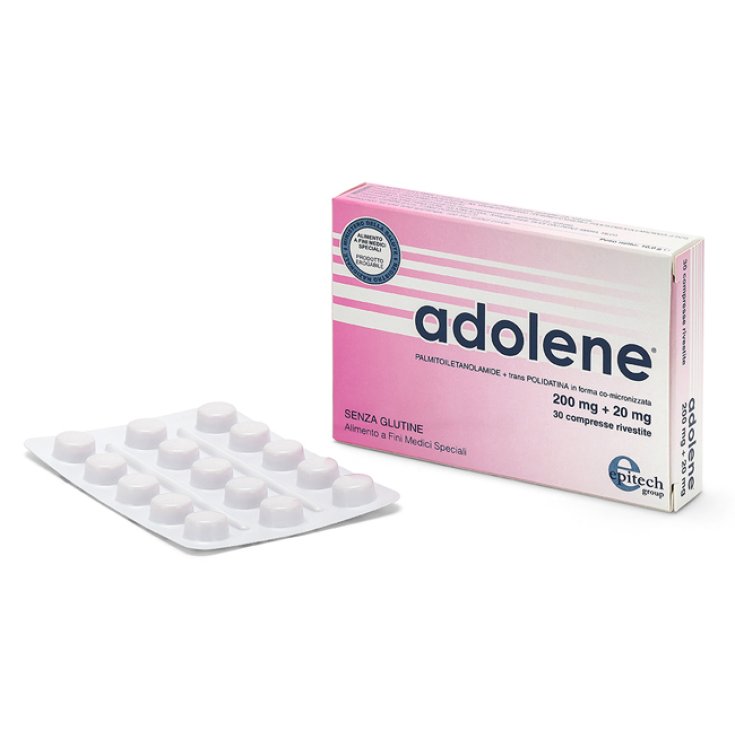Adolene 200mg + 20mg 30cpr
17.63€
20.75€

- Brand: EPITECH GROUP SpA
- Product Code: 924113309
- EAN: 8031359080223
- Availability: In Stock
- Purchase 3 items for 17.28€ each
- Purchase 4 items for 16.92€ each
- Purchase 5 items for 16.57€ each
adolene
1) PRODUCT NAME: ADOLENE.2) QUALI-QUANTITATIVE COMPOSITION.
Active ingredient: ADOLENE cpr Micronized palmitoylethanolamide 200mg + trans-polydatin 20mg per tablet;
Excipients: Single 200mg + 20mg Adolene tablets contain 96.48mg of a mixture of excipients (for the full list see section 8.1).
Without: gluten, lactose, sugars.
3) PHARMACEUTICAL FORM.
Adolene 200 mg +20 mg round, pink tablets.
4) CLINICAL INFORMATION.
4.1) Indications: Palmitoylethanolamide and trans-Polydatin are nutritional factors that act as synergistic biological modulators in the body, favoring the control of physiological tissue reactivity even in the presence of high oxidative stress. The association Palmitoylethanolamide and trans-Polydatin is in fact indicated to counteract the chronic, inflammatory and painful processes of the Areapelvic area, a district in which oxidative stress represents one of the most important stimuli capable of inducing uncontrolled mast cell degranulation, with consequent tissue hyperreactivity and the onset of inflammatory processes characterized by hyperalgesia.
In these subjects it is useful to physiologically counteract the endogenous production deficit of Palmitoylethanolamide, which is determined when the organism, subjected to recurrent inflammatory conditions, exhausts its natural disynthesis capacity by simultaneously modulating the production of regulatory cytokines by the T lymphocytes due to the presence of trans-Polydatin.
Adolene is to be used under medical supervision, in the control of the tissue mechanisms that induce and support Dysmenorrhea.
4.2) Dosage and method of use: On medical indication, in guideline: 2-3 tablets per day for 10 days from the 20th day of the menstrual cycle;
4.3) Contraindications: None
4.4) Warnings and precautions for use: The product is not suitable as a sole source of nourishment. Keep out of the reach of children under 3 years.
4.5) Interactions: Not highlighted.
4.6) Pregnancy: Administration of the product during pregnancy is not recommended due to insufficient data regarding the use of palmitoylethanolamide and trans-polydatin in these situations.
4.7) Effects on ability to drive and use machines: The combination of Palmitoylethanolamide and trans-Polydatin, at the recommended doses, does not affect the ability to drive and use machines.
4.8) Undesirable effects: Up to now undesirable effects have never been reported even after long-term administration and high doses. No cases of addiction or drug addiction have been reported.
4.9) Overdose: Up to now clinical cases of overdose are not known.
5) PHARMACOLOGICAL PROPERTIES
Category: Dietetic Food Intended for Special Medical Purposes.
5.1) Pharmacodynamics: Palmitoylethanolamide is an endogenous N-acylethanolamide, chemically similar to the endocannabinoid anandamide and with a largely common biological activity spectrum. The main difference between the two molecules concerns the inability of Palmitoylethanolamide to interact with the CB1 receptor responsible for the psychotropic effects of the endocannabinoid, therefore its intake is not associated with these central effects. Palmitoylethanolamide has anti-inflammatory effects, affecting both peripheral inflammatory processes and central neuroinflammation, and analgesic effects, evident both in acute pain and chronic neuropathic conditions, underlined by numerous experimental studies in vitro and in vivo and by an increasing number of clinical studies.
Trans-Polydatin (or Piceide) is a glucoside of Resveratrol, a trihydroxystylbenic polyphenol. It possesses a marked antioxidant activity both as a scavenger and as an inhibitor of lipid peroxidation. It has also been shown to be able to control cellular oxidative processes that play an important role in the development of pathologies of the Pelvic System.
5.2) Pharmacokinetics: Palmitoylethanolamide after oral administration in man, of single doses between 300 and 1200 mg, is present in the plasma at dose-dependent concentrations. The plasma peak of Palmitoylethanolamide is observed one hour after dosing; subsequently, plasma levels begin to decline and reach baseline within six hours. Experimental studies have shown that after oral administration, Palmitoylethanolamide is evenly distributed in tissues. After oral administration of trans-Polydatin in the blood, concentrations of glucuronides similar to those detected after administration of trans-Resveratrol were identified and quantified. These metabolites disappear from the plasma within 24 hours of ingestion.
5.3) Mechanisms of action: More mechanisms of action of Palmitoylethanolamide have been described in the various pathological conditions. Two main cellular targets of the molecule are known, mast cell and microglia. The normalization of the excessive activation of these immunocompetent cells involved in peripheral inflammatory processes, of central neuroinflammation and in the processes of acute pain and chronic-neuropathic pain, is responsible for the main effects of Palmitoylethanolamide. At the molecular level, Palmitoylethanolamide interacts with multiple receptors, the main one being the nuclear receptor PPAR-, a receptor involved in the control of inflammatory and neuroprotective processes. In some conditions, Palmitoylethanolamide interacts with the CB2 cannabinoid receptor, a receptor present mainly on immune cells, including mast cells and lamicroglia, whose expression increases significantly in inflammatory conditions. LaPalmitoietanolamide enhances the activity of endogenous Nacylethylamides. The mechanism, called entourage effect, allows Palmitoylethanolamide to interact indirectly with the endocannabinoid and endovanilloid systems. Latrans-Polydatin in addition to having strong antioxidant properties, exerts an anti-inflammatory activity related to its ability to modulate the functions of various immunocompetent cells such as T lymphocytes and precisely regulating the production, by these cells, of regulatory and pro-inflammatory cytokines. it is able to stimulate an immune response while at higher concentrations it inhibits it.
6) CLINICAL EFFECTIVENESS Palmitoylethanolamide and trans-Polydatin are molecules explicating synergistic effects aimed at cells (mast cells and lymphocytes) strongly involved in inflammatory processes and capable of triggering mutual activation processes. Their association has proved to be a valid therapeutic intervention aimed at chronic, inflammatory and painful processes at the level of the pelvic system.
7) TOXICOLOGY AND TOLERABILITY Toxicology studies have shown that the LD / 50 of Palmitoylethanolamide administered by injection (intraperitoneal) in the dog is higher than 400 mg / kg, and in the rat, after single administration with gastric sound, exceeds 5000mg / kg, while after repeated administration always by gastric probe, it exceeds 500 mg / kg / day. Clinical studies carried out with Adolene on a small number of patients demonstrate the excellent tolerability of the combination Palmitoylethanolamide + trans-Polydatin even for very high doses and the absence of clinically relevant changes in the haematological and blood chemistry tests performed.
7.1) Embryotoxicity: No teratogenic or embryotoxic effect of Palmitoylethanolamide was observed after the administration in pregnancy of 50mg / kg of body weight for 12 days. Furthermore, infants of mothers who received PEA before delivery, up to 10 days after delivery, were more resistant to Shigella Shigae toxin. Similarly, infants of mothers who received PEA before delivery showed increasing resistance evident as early as 5 days after birth: these data suggest that mothers may have transferred PEA to neonates via milk. There are no known embryotoxic effects of trans-polydatin.
7.2) Mutagenicity: Although a potential mutagenic effect of Palmitoiethanolamide can be excluded as it is already present in the organism of the mammals, the mutagenicity of PEA was verified using the Amest test, using 5 mutant species of S. typhimurium (TA 1535-TA1537-TA1538-TA98 and TA100). With the Ames test, Palmitoylethanolamide, used at dosages between 10,000 and 1,000 ìg / ml, did not significantly change the number of revertants. No mutagenic effects of trans-Polydatin are known.
7.3) Gastric tolerability: Oral administration of Palmitoylethanolamide at a dose of 50mg / kg (dose approximately 5-times higher than the active dose), and at a dose of 10mg / kg in repeated administration for 5 days does not induce ulcer formation. Furthermore, when administered at a dose of 50 mg / kg concurrently with diclofenac 15 mg / kg, a dosage known to induce gastric lesions, PEA decreases the ulcerogenic potential of NSAIDs, lowering the number of animals that develop ulceration and mitigating any damage.
8) PHARMACEUTICAL INFORMATION
8.1) Excipients: The tablets of Adolene 200 mg + 20 mg contain 96.48 mg of a mixture of excipients (microcrystalline cellulose, magnesium stearate, polysorbatovegetale, croscarmellose sodium, polyvinylpyrrolidone, silica colloidal anhydrous, polyvinyl alcohol) and are coated with a film consisting of a total of 9.5 mg of E120, E1521, E171.
8.2) Incompatibility: Not known.
8.3) Period of validity: 3 years.
8.4) Special precautions for storage: This product does not require any particular storage conditions.
8.5) Nature and contents of container: White PVC / PVC and aluminum blisters in boxes of 30 tablets.
8.6) Special precautions for disposal: No particular instructions.
Cod. 8022

